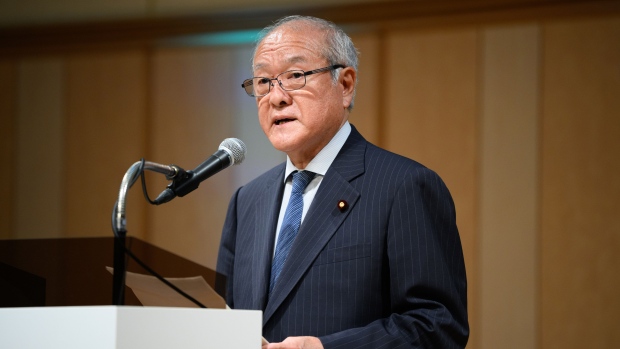Apr 15, 2024
Japan’s Finance Minister Warns on Yen Ahead of IMF-G7 Meetings
, Bloomberg News

(Bloomberg) -- Japan’s finance minister stopped short of issuing his strongest warning on possible market intervention in comments that fueled renewed yen weakness after the currency slumped to a fresh 34-year low overnight.
“We are closely monitoring the latest developments,” Shunichi Suzuki said Tuesday in Tokyo before his departure to Washington for annual International Monetary Fund events and meetings of finance chiefs of the Group of Seven and Group of Twenty nations. “We are prepared to take all possible measures to respond to the situation if it is necessary.”
Suzuki didn’t roll out the threat of taking “bold” action if needed, the most direct hint of possible intervention in foreign exchange markets, a phrase he used last month when the currency approached the 152 mark against the dollar.
The finance minister’s comments come after the yen set a fresh 34-year low of 154.45 following stronger than expected US retail sales figures. With Suzuki refraining from his maximum threat the yen weakened to its low for the day.
Read more: Yen Traders Brace for 160 Even as Intervention Risks Rise
“The government hasn’t jumped in yet, contrary to my expectations,” said Tsuyoshi Ueno, senior economist at NLI Research Institute. “Since volatility has been quite large and speculators’ positions have been heavily tilted toward selling the yen, it’s getting easier for the authorities to call the move speculative. I see them moving soon.”
Japanese currency officials are in a tight spot as they head to the US for meetings with their peers. International agreements call on nations to allow markets to determine exchange rates, though they leave the door open for action if there are excessive movements in the market. Strong verbal interventions or a move into the market would put Japan’s actions in the spotlight.
“Regarding movements in the foreign exchange market, my position is the same as what I’ve said so far, and I would like to refrain from repeating that,” Suzuki said.
JPMorgan Chase & Co.’s private banking unit and Bank of America Corp. see 160 as the next potential milestone for the yen against the dollar. T. Rowe Price is mulling the risk of the yen dropping to around 170 — a level last seen in the 1980s. Japan spent more than $60 billion in 2022 to intervene in the currency market to prop up the yen.
“It’s possible the G20 meeting is somehow causing them to hold back on intervention,” Ueno said.
In the currency options market, the premium to hedge against the dollar dropping against the yen over the coming month, compared with the US currency strengthening, has risen as fears of possible Japanese intervention increase.
The latest US data feed into a picture of economic resilience in the US that again pushes back against expectations the Federal Reserve will cut interest rates in the coming months.
The difference in US and Japanese interest rates and yields is a key factor behind the weakness in the yen, one that makes it harder for Japanese officials to argue that the currency is out of line with economic fundamentals. That suggests intervention won’t change the dynamics and might only slow the pace of moves for the time being.
Suzuki said that currency issues aren’t currently on the agenda for the G20 talks. If the topic comes up, he will explain Japan’s position, he added.
There’s quite a high hurdle for Japan to intervene, said Masahiro Ichikawa, chief market strategist at Sumitomo Mitsui DS Asset Management, pointing to the need for a tacit green light from other countries.
With the yen gradually weakening, rises in import prices moderating, and volatility calming down, Japan may even allow the yen to fall to 156 or 157 per dollar, he said.
(Adds economist comments)
©2024 Bloomberg L.P.






